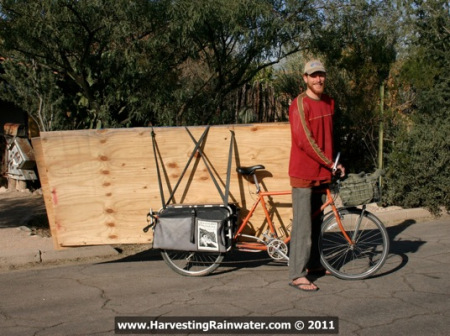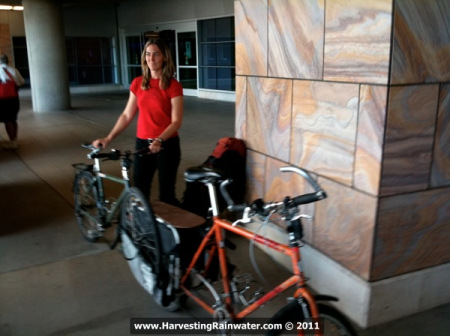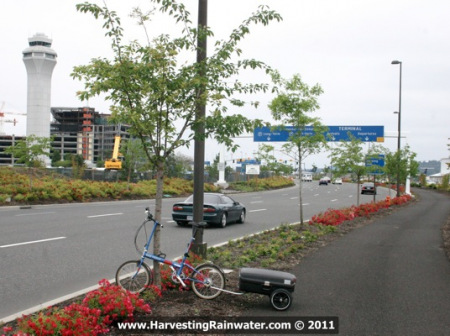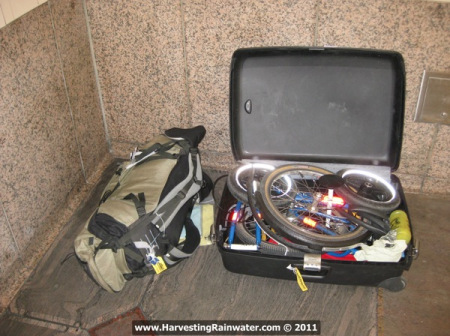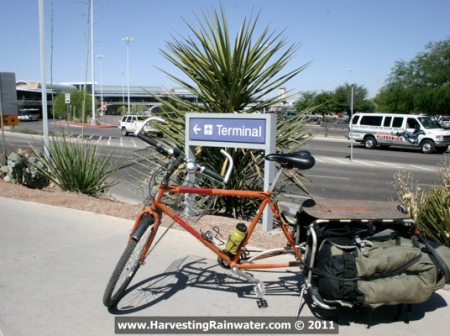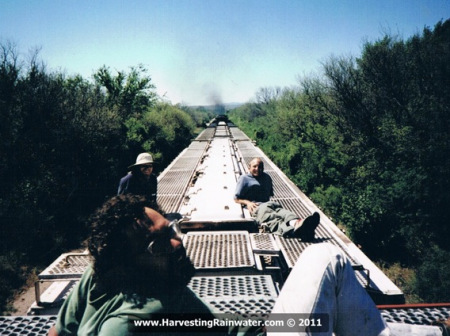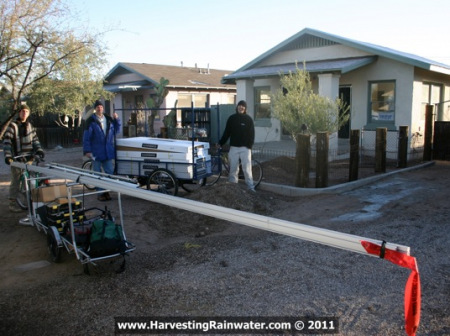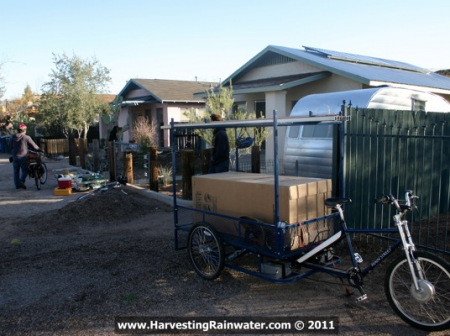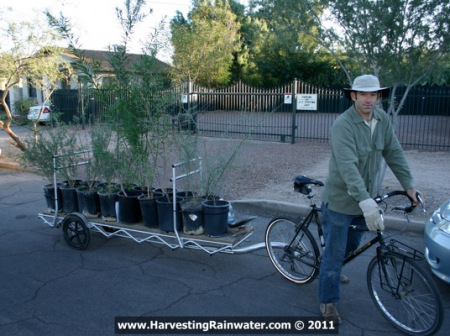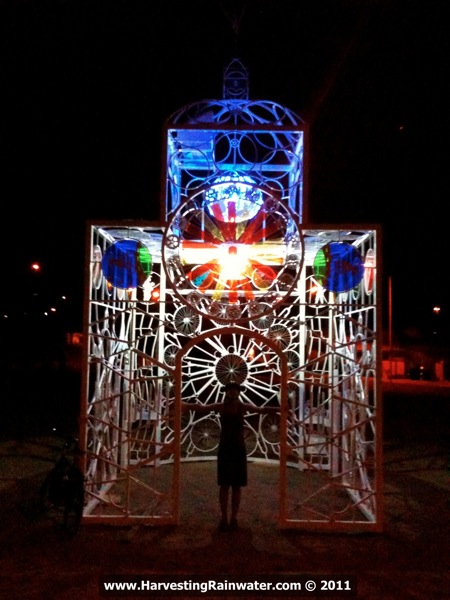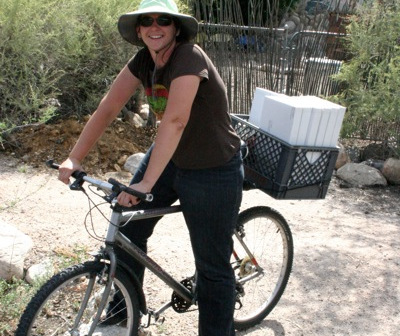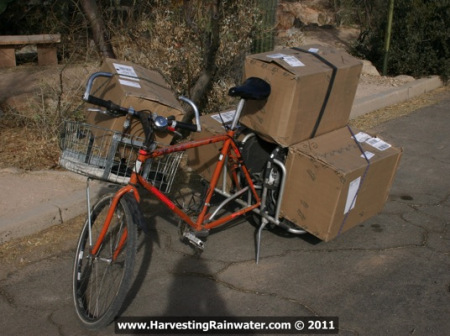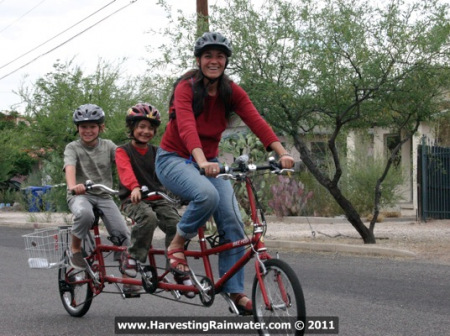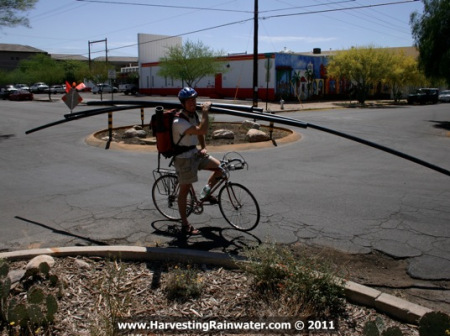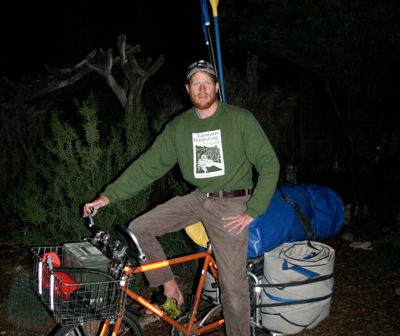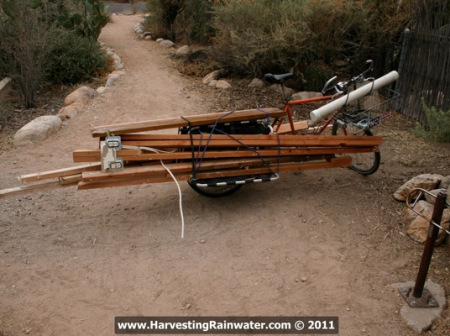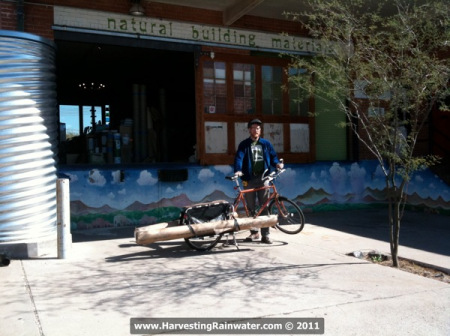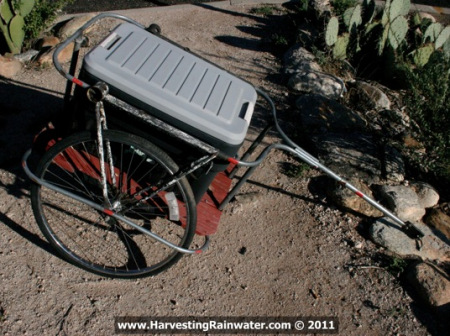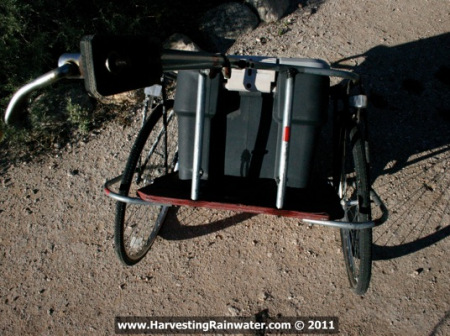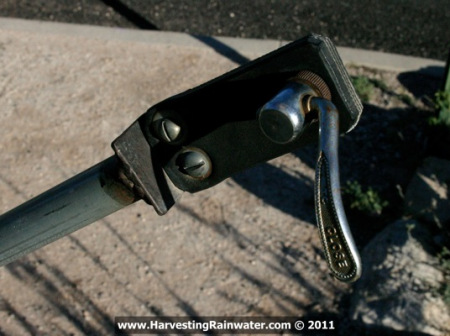Human-Empowered, Enlightened, and Energized Transport
by Brad Lancaster © 2011
www.HarvestingRainwater.com
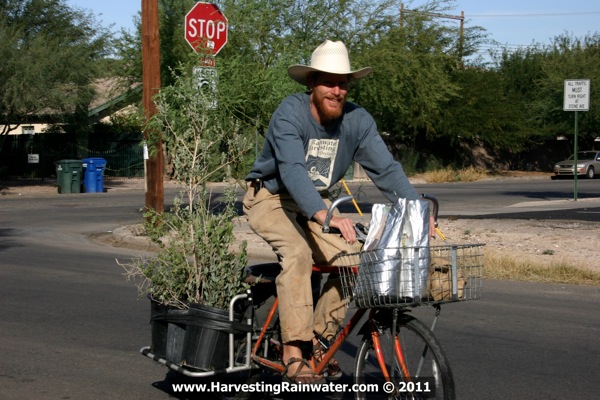
Years ago at a red light I looked into the car beside me and saw the frowning driver’s hair blowing into the back seat as though she were leaning into a mighty storm. But her windows were up. The gale was coming from her air conditioner—on a beautiful day when an open window could just as easily cool and refresh. Then I coughed, and looked back at her tail pipe spewing out toxic exhaust. I was on a bicycle, and loving the day, except for the coughing. And that’s when the simple realization hit me.
Everything we do, every choice we make, has consequences. And no matter how seemingly simple, they can be profound. We can choose to be and live problems—or solutions.
I realized every time I drove (or mechanically cooled myself) I was directly poisoning air, water, soil, and myself. However, every time I rode my bike, my exhaust was never worse than a flatulent. When I drove my car, I fueled it with toxic gasoline from a distant corporation. When I rode my bike, I fueled me, often with a burrito made from locally grown tepary beans and cooked in my backyard solar oven. A burrito I would’ve eaten anyway now tasted even better.
And that’s the essence of it all. I am much happier and healthier when I get around under my own power than when I drive. I typically do not ride my bike along major streets. Instead, I ride through natural corridors, neighborhoods, alleyways, and along bicycle boulevards where it is visually stimulating and safe; I discover salvageable materials; and see and talk to friends. The journey is often as juicy as the destination, and when I arrive I’m zinging with energy.
Driving also directly contributes to increases in traffic and the excessive paving of our communities, which increases the temperatures of and energy consumed within our communities—walking, bicycling, and using public transport reduce all these negatives. Click here for an incredible image showing the space taken up by cars, bikes, and a bus transporting the same number of people.
I sold my car (a cherry 1962 VW crew cab) in 1996, have been gleefully carless ever since, and have greatly reduced my time and distance traveling when commuting. I now average 2,500 bicycled commuter miles per year.
The moment I sold my car, I got an annual raise of over $7,000. The American Automobile Association (AAA) estimates the average American annually pays nearly $10,000 to own, operate, fuel, insure, and maintain the average automobile.
In its report “The True Cost of Driving,” The Santa Cruz County Regional Transportation Commission estimates it costs $1.19 per mile to drive a vehicle (86.3¢ in direct driver’s expenses and 32.9¢ in societal costs). This adds up to $15,496 per year (13,000 miles x $1.19).
Check out Sightline Institute’s great graph (below) on how many hours we work to pay for 15 gallons of gasoline.
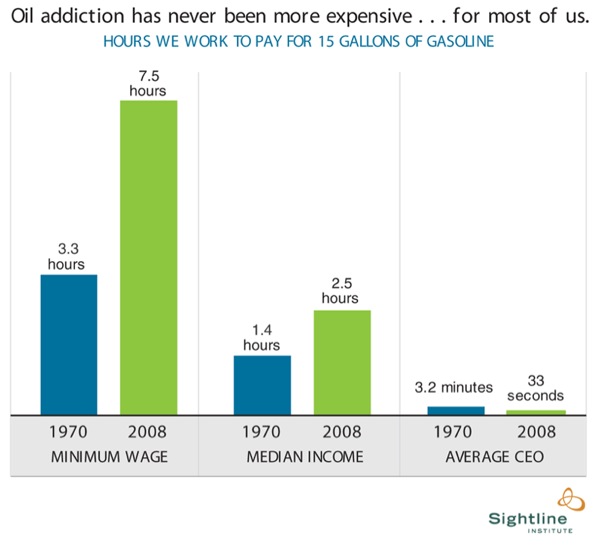
How I do live without owning a car?
I live in a central, mixed-use, pedestrian-scaled neighborhood, a few blocks away from major bus routes, where I can easily get the majority of my needs met within a 3- to 5-mile (1.8- to 3-km) radius. When working in town, I consciously select work that is closer to home to keep my typical in-town travel radius smaller and more easily bikeable, although I do venture much further out on occasion. And I started playing with the bicycling lifestyle long ago while I still lived with my folks in their “remote” suburban home 10 miles from my work. Plus I’m always advocating for more human-powered transport infrastructure and policy in my community and beyond.
Having sold my car, it is now far more convenient to ride a bike, walk, or take public transport than to arrange to borrow a vehicle. Convenience is key. And even when I’m feeling tired at the beginning of a ride, once I get going (and afterward) I am always glad I did.
I have an Xtracycle Free Radical Trucker (formerly called a Cargo Loader) that extended my 20-year-old mountain bike so I can use it as a bike truck. I can pack 200 lbs (90 kg) on its back, carry people, other bikes, building materials, trees, groceries, and more. Before I had my Xtracycle I just used my mountain bike with bike bags, a big basket, and when needed, a bike trailer. Photos of the trailer, made from salvaged materials, can be seen farther down in this blog post.
Note: Xtracycle now also offers whole bikes such as the Edgerunner and the Cargo Joe, a sidecar, electrical assist, and much more. In addition, Surly makes a heavy-duty Xtracycle-compatible bike—it’s called the Big Dummy.
I have a second bike as back up, just in case I wake up late to a flat tire or the like. This back-up bike is a used Bike Friday, a foldable bike which I sometimes put in a suitcase and which becomes a bike trailer when I travel to super bike-friendly destinations such as Portland, Oregon, home of the Village Building Convergence and the World’s Largest Naked Bike Ride.
A friend, David Omick, rides his Bike Friday every other year from Tucson to Corvallis, Oregon. The Bike Friday can be carried onto a bus, and also easily adjusts for a wide range of heights of riders (Art Ludwig put a super long seat post and quick-release seat-post clamp on his old bike for the same purpose). I take my Bike Friday or other bikes on my Xtracycle when I pick up friends and family from the airport, bus station, or train station. We take a scenic route home, hitting taco stands along the way, thus everyone I’ve picked up has always been grateful for the pick-up adventure.
I live in a household and a community where we talk and share. I live with my brother and sister-in-law who own a small truck, which I can borrow at times of true need. And if that truck is not available, I can call on a number of neighbors to borrow their vehicle or convince them to go with me (hiking from a distant trailhead, for example). When I do have the use of a car/truck, I pack in as many errands as I can that require one (usually picking up heavy stuff). I try never to ride empty, but instead to plan trips and fill it up. I put more gas into the borrowed vehicle than I use, often filling the tank, so the lenders benefit and feel good lending to me again in the future.
We have extra bikes and bike parking at home so when people come to visit we can lend them bikes and we can all ride together, rather than drive, to local destinations. I also conduct bicycle tours of local sustainability, water-harvesting, and regenerative design sites and projects. I lend out bikes for these tours, and if needed we can rent more bikes for just $5 per day from BICAS, three blocks down the street.
For out-of-town trips I try to take Amtrak whenever possible (the station is a 15-minute walk from home), but I can also take the bus (a 25-minute walk from home), plane (1 hour bike ride from home, which juices me before a long trip and revives me after one), carpool, rent a car from a friend, or rent a car from a car rental service (5-minute walk from home), hitch hike, get a ride from Craig’s List, or hop a freight train.
Note: I, and many friends, have found that the first long bicycle or walking commute can be tiring when first switching from driving to bicycling or walking—we’re just out of shape. But then it just gets easier and funner. After just one or two weeks of daily bike riding and/or walking, the body is adjusted, happy, and in shape.
The Big Carbon Picture
Living a solution such as using a bicycle as the primary mode of transport is easy at home, but I find it more challenging when traveling. I’ve been noticing this more and more lately, as I am getting an increasing number of requests to teach and present across the country as well as abroad.
I really struggle with how best to spread the word on water-harvesting and integrated regenerative design/living in a way that does not compound climate change. And anytime we use fossil fuels we are contributing to climate change and worsening of air, water, and soil quality.
Check out Sightline Institute’s great breakdown (below) of how much carbon is emitted per mile based on mode of transport chosen.
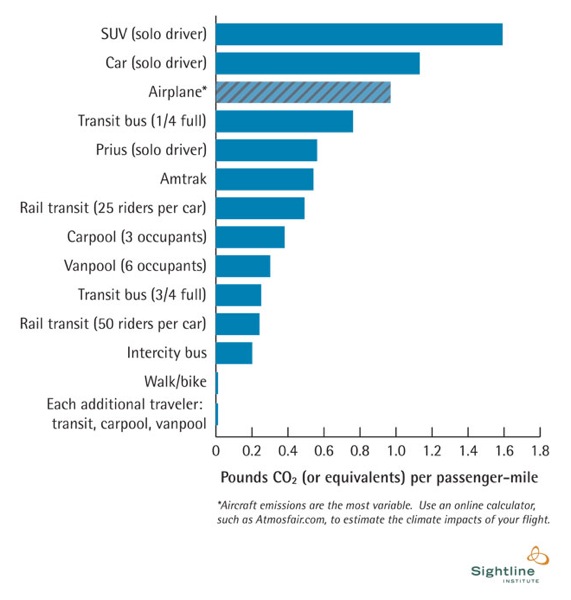
I live in the open, spread out, and often-sprawling western United States where 44% of fossil fuel carbon emissions are from transportation, by far the biggest source of emissions. Electric power is the second largest source of emission (31%), but my home (from which I run my business) is 100% rooftop-solar-powered. Check out Sightline Institute’s great graphics and data (below) on CO2 Emissions from Fossil Fuels by Sector.
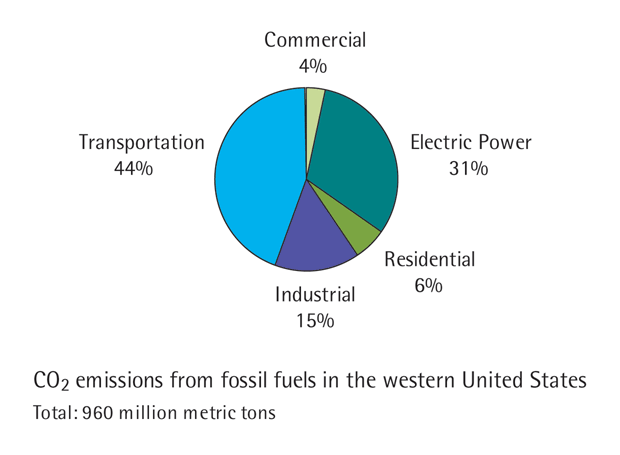
Although the consequences of carbon emissions may not seem as direct and immediate as breathing in toxic exhaust, I believe they are. I feel we need to take immediate action. The Earth Policy Institute estimates we must reduce our current carbon emissions by 80% by the year 2020.
I don’t think I have the answer for this one (though the Bringing It Back Home section at the end is my best shot at addressing the question), but I’m actively looking for, starting with, and practicing steps that may get me there. I find all steps consciously and proactively taken toward a goal enable me to take the next step, whether I succeed or fail.
So here is what I’m currently trying in terms of long-distance travel:
• I travel in regions. If an event gets me to a certain locale, then I reduce my fee for other hosts in the area who organize events for me. That way I can spread the word more efficiently to more people while I’m there and I don’t have to set up another separate trip to come back. And wherever I go, I try to train other trainers and connect them with the local resources, to enhance and celebrate their abilities, so they will carry on the work in their region, where they are the local in situ experts (I like to call them “inperts”).
• I opt for lower carbon-emitting travel options whenever possible. These typically end up being the most enjoyable and memorable. A two-week hiking trek with my brother from the Grand Canyon to Boulder, Utah, where I needed to get to work for the Boulder Outdoor Survival School was a huge highlight. I also love the train due to its low-carbon footprint compared to plane and auto, and because it is so relaxing. It is cheap; has big seats; lots of space; power for computer and phone; an observation car for stretching, lounging, and conversation; great views; and you stop in the historic heart of every community, built when all was done at the pedestrian scale, so you can step out and venture forth under your own power. I can pick up the train in Tucson (for a fraction of the cost of flying) at 10:30 pm after catching live music at Hotel Congress across the street from the station, fall asleep, then wake up well rested at around 8 am in Los Angeles, CA, in the incredibly beautiful art deco Union Station. In Mexico the buses are phenomenal, and services such as Tufesa could certainly teach Greyhound a thing or two about enhanced comfort, convenience, and reliability. And as with all public/mass transport, someone else is driving so I can work, read, play, eat, sleep as I travel.
• I stay with friends, friends to be, and family whenever possible as opposed to staying in motels and hotels. This builds community, is much more fun and social, and the food is way better and more locally sourced. And my hosts typically lend me a bike to get where I need to go, and/or we all bike around together. And if I do end up in a hotel, I take the stairs rather than the elevator for much needed on-the-road exercise, and always put out the Do Not Disturb sign so the sheets and towels are not needlessly changed and washed.
• I am continually revising my books and website (www.HarvestingRainwater.com), I’m working on getting my books translated in other languages (Arabic is the first, Turkish is in the works, and I’m working on Spanish) and I’ve started filming videos and conducting talks in DVC format, so the information can travel instead of me.
• Whenever I travel, my hosts pay a carbon offset to an organization, The Local Trust, that utilizes the offsets locally in Tucson. This recurringly links me and others to the consequences of our actions, while enhancing the local economy and ecosystem, and doing so where we can check up on the progress and participate.
Bringing it back home
Ultimately, I’m re-prioritizing my life to spend more time at home, exploring and adventuring locally to deepen my understanding and appreciation of home, and pushing to enhance the following:
- the local human-powered transport experience,
- local renewable water (we passively harvest about 100,000 gallons of rainwater and greywater per year in the soil of our 1/8th acre site to enhance instead of deplete the aquifer),
- local renewable power (100% of home and business power and hot water come from rooftop solar panels and a solar water heater),
- local food (we grow food at home with harvested on-site water, and buy from other local growers at farmers’ markets, local restaurants serving locally-grown food, and our community’s food co-op),
- local air (we avoid polluting the air by avoiding driving as much as possible and not getting power from the burning of coal, and instead grow air-filtering, passive-cooling, food-producing, rainwater-irrigated vegetation at home and in the neighborhood),
- local soil (we compost, rather than throw away our “wastes”), and
- local community with efforts that begin at home (we do much of this with friends, neighbors, and in workshops open to the public) and spread by example.
2014 Update: Brad Lancaster was awarded the Tucson Bicycle Commuter of the Year Award.
For more on all the above, see my books and website and the resources below.
Bicycle and human-powered transport resources:
www.WalkScore.com
Great tools, including an app to figure out the best places to live, work, school, and recreate that are easily walkable.
Bicycle transported and powered band
Ginger Ninjas
Pedal People: a worker-owned human-powered delivery and hauling service in Northampton, Massachusetts, area
Their winter gear
Freewheelin Farm: an organic farm in Santa Cruz, CA, that delivers its CSA shares by bicycle and bicycle trailer
Pedal to Petal Bicycle Compost Pick Up
The Pedaling Arborist Aleck MacKinnon in Tucson
Bicycle-powered theater:
Robert Newman’s History of Oil
Bicycle Power for Rent to Power Your Eco-Minded Events
This wonderful set up by Open Streets Calgary enabled me to pedal a stationary bicycle to self-power a microphone and speakers for the presentation I gave at a Waterlution event in Calgary, Canada, in September 2012. This was a long-time dream come true and a lot of fun, especially since my talk was on the Water-Energy-Carbon Nexus.
Rock the Bike
An organization based in Berkeley, CA, providing pedal-powered sound and light equipment, blenders, and linking to bicycle-riding bands
Bike Art
Bike Church in Tucson
Salvaged and repurposed bikes and gear:
BICAS (Tucson)
Bike Church (Santa Cruz)
bike buckets
Bike food/beverage carts:
Beer bike (click here)
TFS Solar power and solar hot water company using bikes as transportation
BionX electrical assist motor for bicycles — an electric-assist or -powered bicycle is far more efficient than an electric car — since the electricity is mainly being used to move you, not a heavier car. TFS uses these to help pull 8-foot long bicycle trailers to and from works sites.
Bafang electrical assist mid drive motor
Bicycling gear for kids:
iBert Safe T-Seat top-tube bike seat for kids — my nephew loves it!
Burly child trailer (check second-hand sports-equipment shops and Craig’s List for good deals on used ones) — can fit multiple kids.
Xtracycle accessories for kids and families
Bike Helmet Shade Brim
I have long avoided wearing a bike helmet since I could not find one that also protected me from the sun. But with the Da Brim bike-helmet wrap-around sun visor on a Nut Case helmet, I now ride with head and sun protection.
Bicycle-oriented maps:
www.mapmyride.com — Find designated bike routes or those created by other riders, or create your own routes and log them for others’ use
www.bikemap.net/app — Find designated bike routes or those created by other riders, or create your own routes and log them for others’ use
maps.google.com — Their bike routes are still in beta, so lots of room for improvement. If you know of a good alternative, let us know!
Bike and pedestrian tours of sustainable stormwater sites in Portland, Oregon
Bicycle and Human-Powered Transport Advocacy Groups:
Living Streets Alliance
People Power
Resources for Greener, Water-Harvesting, Bikeable and Walkable Streets and Public Rights-of-Way:
Chapter 12 of Rainwater Harvesting for Drylands and Beyond, Volume 2
In-street water-harvesting traffic calming images
Street-side water harvesting images
Cyclovia — A wonderful event/celebration where miles of whole streets are blocked off to automobiles so they become corridors of 100% human-powered transportation and joy
Tucson Cyclovia
All Souls’ Procession
An incredible non-motorized procession and celebration of over 10,000 people of all ages that is one of the best annual events in Tucson
Pedal Palooza in Portland (Oregon)
Bicycle/Water/Transportation Factoids:
- It takes about 13 gallons of water to produce one gallon of gasoline
- One quart of oil can contaminate up to a quarter million gallons of drinking water or cause an oil slick almost 2 acres in size (clicking will download a PDF, about 45 KB)
See the new, full-color, revised editions of Brad’s award-winning books
– available a deep discount, direct from Brad:

Volume 1


